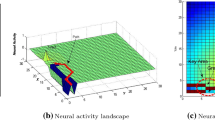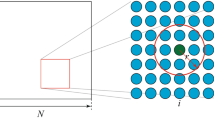Abstract
The paper proposes an algorithm for multi-robot coordination and navigation in order to intercept a target at a long distance. For this purpose, a limit cycle based algorithm using a neural oscillator with phase differences is proposed. The state of target is unknown, under the assumption that it is stationary or in motion with constant unknown speed along a straight line. Using the proposed algorithm, a group of robots is intended to move towards the target in such a way that the robots surround it. While moving to the target, self-collision between the robots is avoided. Moreover, a collision avoidance with static obstacles as well as dynamic target is realized. The robots reach the target at a desired distance, keeping uniformly distributed angles around the target. The algorithm is further extended so that a static interception point for the target can be estimated in place of pursuing a dynamic target, which is referred to as a virtual target in this paper. In other words, the robots move towards the virtual target instead of the actual target. The robots ultimately encircle the actual target when they arrive at the virtual target. The effectiveness of the proposed method is verified through simulation results.
Similar content being viewed by others
References
Paley, D.A., et al.: Collective motion, sensor networks, and ocean sampling. In: Proceeding of the IEEE, vol. 95, pp 48–74 (2007)
Triplett, B.I., et al.: Cooperative estimation for coordinated target tracking in a cluttered environment. Mobile Networks and Applications 14(3), 336–349 (2009)
Franchi, A., et al.: Distributed target localization and encirclement with a multi-robot system. In: 7th IFAC Symposium on Intelligent Autonomous Vehicles (2010)
Manzoor, S., et al.: Neural oscillator-based multi-robot coordination algorithm to catch-observe-protect a target. In: IEEE International Conference on Mechatronics and Automation (2015)
Jennings, J.S., et al.: Cooperative search and rescue with a team of mobile robots. IEEE Int. Conf. on Robotics and Automation, 193–200 (1997)
Dong, W., et al.: Cooperative control under-actuated surface vessels. IET Control Theory and Applications 4(9), 1569–1580 (2010)
Bai, H., Wen, J.T.: Cooperative load transport: a formation-control perspective. IEEE Trans. Robot. 26(4), 742–750 (2010)
Wang, Y., et al.: Cooperative control of multi-missile systems. IET Control Theory and Applications 9, 441–440 (2014)
Werfel, J., et al.: Designing collective behavior in a termite-inspired robot construction team. Science 343, 754–758 (2014). doi:http://dx.doi.org/10.1126/science.1245842
Das, G.P., et al.: A distributed task allocation algorithm for a multi-robot system in healthcare facilities. J. Intell. Robot. Syst. 80(1), 33–58 (2015)
Schenato, L., Oh, S., Sastry, S., Bose, P.: Swarm coordination for pursuit evasion games using sensor networks. IEEE Int. Conf. on Robotics and Automation, 2493–2498 (2005)
Saber, R.O.: Flocking for multi-agent dynamic systems: algorithms and theory. IEEE Trans. Autom. Control 51(3), 401–420 (2006)
O’Grady, R., et al.: Self-assembly strategies in a group of autonomous mobile robots. Springers Autonomous Robots 28(4), 439–455 (2010)
Liu, S., Sun, D., Zhu, C.: Coordinated motion planning for multiple mobile robots along designed paths with formation requirement. IEEE/ASME Transactions on Mechatronics 16(16), 1021–1031 (2011)
Jiang, Q., Kumar, V.: The inverse kinematics of cooperative transport with multiple aerial robots. IEEE Trans. Robot. 29(1), 136–145 (2013)
Dutta, R., et al.: A cooperative formation control strategy maintaining connectivity of a multi-agent system. EEE/RSJ Int. Conf. on Intelligent Robots and Systems, 1189–1194 (2014)
Franchi, A., et al.: Decentralized multi-robot encirclement of a 3D target with guaranteed collision avoidance. Springers Autonomous Robots, 11 (2015). First online
Moors, M., et al.: A probabilistic approach to coordinated multi-robot indoor surveillance. IEEE/RSJ Int. Conf. on Intelligent Robots and Systems, 3447–3452 (2005)
Balch, T., Arkin, R.C.: Behavior-based formation control for multi-robot teams. IEEE Transitions on Robotics and Automation 14(6), 926–939 (1998)
Erdogmus, P., et al.: Heuristic optimization algorithms in robotics. Serial and Parallel Robot Manipulators - Kinematics, Dynamics, Control and Optimization, InTech Publisher, 311–338 (2012)
Desai, J.P.: A graph theoretic approach for modeling mobile robot team formations. J. Robot. Syst. 19(11), 511–525 (2002)
Saber, R.O., Murray, R.M.: Graph rigidity and distributed formation stabilization of multi-vehicle systems. IEEE Conf. on Decision and Control 3, 2965–2971 (2002)
Khatib, O.: Real-time obstacle avoidance for manipulators and mobile robots. Int. Journal of Robotics Research 5(1), 90–98 (1986)
Qu, Z., et al.: Cooperative control of dynamic systems with application to autonomous vehicles. IEEE Transactions of Automatic Control 53(4), 894–911 (2008)
Clark, M.R., et al.: Coupled oscillator control of autonomous mobile robots. Springer, Autonomous Robots 9(2), 189–198 (2000)
Sepulchre, R., et al.: Collective motion and oscillator synchronization. Cooperative Control: Lecture Notes in Control and Information Science 309, 189–205 (2005)
Paley, D.A., et al.: Oscillator models and collective motion. In: Proceedings of Block Island Workshop on Cooperative Control (2003)
Sepulchre, R., et al.: Stabilization of planar collective motion: all-to-all communication. IEEE Transaction on Automatic Control 52(4), 811–824 (2005)
Klein, D.J., et al.: Collective motion: bi-stability and trajectory tracking. In: IEEE American Control Conference (2002)
Klein, D.J., Morgansen, K.A.: Controlled collective motion for trajectory tracking. In: IEEE American Control Conference (2006)
Kim, D.H., et al.: A real-time limit-cycle navigation method for fast mobile robot and its application to robot soccer. Robot. Auton. Syst. 42(1), 17–30 (2003)
Quigley, M., et al.: Target acquisition, localization, and surveillance using a fixed-wing mini-UAV and gimbaled camera. Int. Conf. on Robotics and Automation, 2600–2606 (2005)
Wu, M., et al.: A distributed multi-robot cooperative hunting algorithm based on limit cycle. Int. Asia Conf. on Informatics in Control, Automation and Robotics, 156–160 (2009)
Benzerrouk, A., et al.: Navigation of multi-robot formation in unstructured environment using dynamical virtual structures. IEEE/RSJ Int. Conf. on Intelligent Robots and Systems, 5589–5594 (2010)
Sun, L., et al.: Distributed probabilistic search and tracking of agile mobile ground targets using a network of unmanned aerial vehicles. Springer International Publishing (2014)
Kothari, M., et al.: Cooperative target capturing with incomplete target information. J. Intell. Robot. Syst. 68, 373–384 (2013)
Fu, X., et al.: UAV Mobile ground target pursuit algorithm. J. Intell. Robot. Syst. 68(3), 359–371 (2012)
Shin, H.S., et al.: Earliest intercept geometry guidance to improve mid-course guidance in area air-defence. Int’l J. of Aeronautical and Space Sci. 11(2), 118–125 (2010)
Wu, M., et al.: Integrated heterogeneous multi-robot system for collaborative navigation. Frontiers in the Convergence of Bioscience and Information Technologies, 651–656 (2007)
Kuramoto, Y.: Self-entrainment of a population of coupled non-linear oscillators. International Symposium on Mathematical Problems in Theoretical Physics Lecture Notes in Physics 39, 420–422 (1997)
Saksguchi, H., Kuramoto, Y.: A soluble active rotator model showing phase transitions via mutual entrainment. International Symposium on Mathematical Problems in Theoretical Physics Lecture Notes in Physics 76(3), 576–581 (1986)
Corke, P.: Robotics, vision and control: fundamental algorithms in MATLAB. Springer-Verlag, Heidelberg (2011)
Author information
Authors and Affiliations
Corresponding author
Additional information
This work was supported in part by the Convergence Technology Development Program for Bionic Arm through the National Research Foundation (NRF) of Korea funded by the Ministry of Science, ICT & Future Planning (MSIP) (NRF-2015M3C1B2052811), and in part by the Agency for Defense Development (Grant UD160001DD), Republic of Korea.
Rights and permissions
About this article
Cite this article
Manzoor, S., Lee, S. & Choi, Y. A Coordinated Navigation Strategy for Multi-Robots to Capture a Target Moving with Unknown Speed. J Intell Robot Syst 87, 627–641 (2017). https://doi.org/10.1007/s10846-016-0443-z
Received:
Accepted:
Published:
Issue Date:
DOI: https://doi.org/10.1007/s10846-016-0443-z




